Apollo Program (1963-1978)
Gemini | Apollo | Hubble
Space Telescope

The Apollo program is one of the most famous in American history,
if not the history of the world, for it represents the first time any human set
foot on an extraterrestrial land mass.
Apollo 1 (original designation was Apollo 204):
- Crew: Edward White, Virgil Grissom, Roger Chaffee
- Destroyed on January 27, 1967; planned launch was February 21, 1967.
- One of the worst tragedies in space flight, the Apollo 1 craft was destroyed
during a pre-flight test at Cape Canaveral. All three men were killed. They
had been taking part in a training exercise in the Apollo Command Module on
the Saturn V rocket that would be used, but it was un-fueled.
- Several minor problems had occurred which delayed testing, but at 6:31 P.M.
the crew smelled fire. The craft had been saturated with oxygen for the test,
and the fire spread quickly. Under ideal circumstances, it would have taken
90 seconds at least to get the door open, which could only be opened inward
and was being held closed.
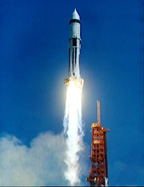
Apollo 2 and 3: There were no craft named Apollo 2 or 3.
Apollo 4 (also called AS-501):
- No crew.
- Launched November 9, 1967; landed November 9, 1967.
- The main purpose of this craft was to take the the Apollo Command and Service
Module (CSM) into Earth orbit and to test all aspects of the Saturn V launch
vehicle.
- Secondary objects were to take images of Earth, tests of structural integrity,
compatibility of launch vehicle and spacecraft, heat shield and thermal seal
integrity, overall reentry operations, launch loads and dynamic characteristics,
stage separation, launch vehicle subsystems, the emergency detection system,
and mission support facilities and operations.
Apollo 5 (also called AS-204):
- No crew.
- Launched January 22, 1968.
- This was the first test flight of the Lunar Module (LM).
- The primary objectives of this were to verify ascent and descent stages
of the propulsion systems, restart options, spacecraft structure, LM staging,
2nd stage and instrument unit orbital performance.
Apollo 6 (also called AS-502):
- No crew.
- Launched April 4, 1968; splashdown April 4, 1968.
- This was the final qualification mission of the Saturn V launch vehicle
and Apollo spacecraft for the manned Apollo missions.
- The primary objectives were to demonstrate structural and thermal integrity,
compatibility of the launch vehicle and spacecraft, confirm launch loads and
dynamic characteristics, verify stage separations, propulsion, guidance, control,
electrical systems, emergency detection system, mission support facilities
and operations, and the Command Module recovery.
Apollo 7:
- Crew: Walter Schirra, Jr., Donn Eisele, and Walter Cunningham.
- Launched October 11, 1968; splashdown October 22, 1968.
- This was the first manned Apollo mission, and it orbited the Earth.
- The primary objectives of this mission were to demonstrate the Command and
Service Module (CSM), crew, launch vehicle, the mission support facilities
performance, and to demonstrate the CSM rendezvous capability.
- Two photographic and three medical experiments were conducted by the crew,
as well.
Apollo 8:
- Crew: Frank Borman, James A. Lovell, and William A. Anders.
- Launched December 21, 1968; reentry December 27, 1968.
- This was the first manned Apollo mission, and it was the first U.S. manned
mission to orbit the moon, which it reached on December 24, 1968. It orbited
the moon twice in a very elliptical orbit, and then orbited eight times in
a near-circular orbit.
- The primary objectives were to test the Apollo command module systems of
communications, tracking, and life support in a lunar orbit, and it allowed
for the evaluation of crew performance on a lunar orbiting mission.
- The crew provided photographs of the lunar surface, both near and far side,
in order to obtain information pertinent to the eventual landing of people.
Apollo 9: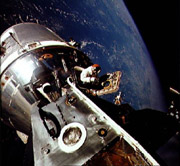
- Crew: James McDivitt, David Scott, and Russell Schweickart.
- Launched March 3, 1969; reentry March 13, 1969.
- This was the first crewed mission that included the Lunar Module (LM),
and it was used in Earth orbit.
- The primary objectives of this Apollo flight was to test all aspects of
the LM in Earth orbit, which included operation of the LM as an independent
self-sufficient spacecraft, performance of docking, and rendezvous maneuvers.
Besides these and simulations of maneuvers that would be used in the planned
Moon landing, other objectives were to checkout the overall performance of
the launch vehicle, spacecraft systems, crew, and procedures.
- A multispectral photographic experiment was also conducted by the astronauts.
Apollo 10:
- Crew: Thomas P. Stafford, John W. Young, and Eugene A. Cernan.
- Launched May 18, 1969; reentry May 26, 1969.
- This was the second Apollo mission to the moon, the first to travel with
the entire craft, and it reached lunar orbit on May 21, 1969. It brought the
manned Lunar Module to within 75,600 km (47,000 miles) of the surface of the
moon (May 23, 1969), where the astronauts made two passes over the future landing
site for the Apollo 11 LM.
- The primary objectives here were to demonstrate crew, space vehicle, and
the mission support facilities during a manned lunar mission, and the evaluation
of the LM performance in lunar orbit and the lunar environment.

Apollo 11:
- Crew: Neil A. Armstrong, Michael Collins, Edwin E. Aldrin, Jr.
- Launched July 16, 1969; reentry July 24, 1969.
- Landed on the moon on July 20, 1969 in Mare Tranquillitatis (the
Sea of Tranquility).
- This was the first mission in which humans walked on the moon. Both Neil
Armstrong and Edwin Aldrin, Jr. landed in the Lunar Module while Michael Collins
remained in orbit in the Command and Service Module.
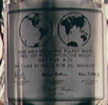
- While on the moon, the astronauts set up experiments, took photographs,
and collected samples.
- They left a plaque on the moon, which is signed by all three astronauts
and by President Nixon; the plaque (right) says:
HERE MEN FROM THE PLANET EARTH
FIRST SET FOOT UPON THE MOON
JULY 1969 A.D.
WE CAME IN PEACE FOR ALL MANKIND
|
Apollo 12: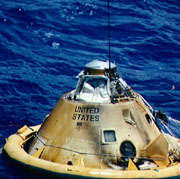
- Crew: Charles Conrad, Jr., Richard F. Gordon, Alan L. Bean.
- Launched November 14, 1969; reentry November 24, 1969.
- Landed on the moon on November 19, 1969 in Oceanus Procellarum (the
Ocean of Storms).
- This was the second mission where astronauts walked on the moon: Charles
Conrad and Alan Bean walked on the moon while Richard Gordon remained in lunar
orbit.
- While on the moon, the astronauts set up experiments, took photographs,
collected samples, and examined the Surveyor 3 craft that had landed on the
moon 2.5 years prior, of which they removed pieces for study back on Earth.
This was also the crew that placed a U.S. flag on the moon.
Apollo 13:
- Crew: James A. Lovell, John L. Swigert, Jr., and Fred W. Haise, Jr.
- Launched April 11, 1970; reentry April 17, 1970.
- This was to be the third mission to carry humans to the moon, but an almost
fatal malfunction occurred. An explosion in the No. 2 oxygen tank 56 hours
into the mission ruptured a line or valve in the No. 1 oxygen tank, which caused
it to lose oxygen very rapidly. All oxygen was lost within three hours, along
with water, electricity, and propulsion.
- The entire crew was able to survive and return safely to Earth.

Apollo 14:
- Crew: Alan B. Shepard, Jr., Stuart A. Roosa, and Edgar D. Mitchell.
- Launched January 31, 1971; reentry February 9, 1971.
- Landed on the moon on February 5, 1971 in Fra Mauro.
- This was the third mission where humans walked upon the moon. Alan Shepard,
Jr. and Edgar Mitchell landed on the moon while Stuart Roosa stayed in the
lunar orbit.
- While on the moon, the astronauts set up experiments, took photographs,
and collected samples.
Apollo 15:
- Crew: David R. Scott, Alfred M. Worden, and James B. Irwin.
- Launched July 26, 1971; reentry August 7, 1971.
- Landed on the moon on July 30, 1971 in Hadley Rille/Apennines.
- This was the fourth mission where humans walked upon the moon. David Scott
and James Irwin landed on the moon while Alfred Worden stayed in the lunar
orbit.
- While on the moon, the astronauts set up experiments, took photographs,
and collected samples.
Apollo 16:
- Crew: John W. Young, Thomas K. Mattingly II, and Charles M. Duke, Jr.
- Launched April 16, 1972; reentry April 27, 1972.
- Landed on the moon on April 21, 1972 in Descartes.
- This was the fifth mission where humans walked upon the moon: John Young
and Charles Duke landed on the moon while Thomas Mattingly stayed in lunar
orbit.
- While on the moon, the astronauts set up experiments, took photographs,
and collected samples. Its primary mission was to explore the Descartes highlands
area because most of the lunar surface is similar to the Descartes highlands,
and such an area had not previously been explored.
Apollo 17: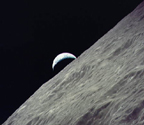
- Crew: Eugene A. Cernan, Ronald E. Evans, and Harrison H. Schmitt.
- Launched December 7, 1972; reentry December 19, 1972.
- Landed on the moon on December 11, 1972 in Raurus-Littrow.
- This was the sixth and final Apollo mission where humans walked upon the
moon: Eugene Cernan and Harrison Schmitt (the first scientist to land) landed
on the moon while Ronald Evans stayed in lunar orbit.
- While on the moon, the astronauts set up experiments, took photographs,
and collected samples. Its primary mission was to explore the Descartes highlands
area because most of the lunar surface is similar to the Descartes highlands,
and such an area had not previously been explored.
Apollo 15, 16, and 17 provided important data on geological
features; it allowed the formation of theories as to the formation of the moon's
core, mantle, and crust.
The twelve men who walked on the Moon between 1969 and 1972
brought back over 1/3 of a ton of moon rocks.
All were launched from Kennedy Space Center in Florida by the
Saturn V rocket.
- A thrust of 7.6 million pounds took 2.5 minutes to take the rocket to a 40
mile (65 km) altitude, at a speed of 6,000 mph (9,600 kph).
- After the first stage detached, falling into the Atlantic Ocean, the second
stage took the craft to 115 miles (185 km) above sea level, with a thrust of
one million pounds, at speeds over 15,000 mph (25,000 kph).
- After the second stage detached, the third stage brought the craft into a
stable Earth orbit.
- The astronauts performed systems checks.
- The third stage brought them to the moon.
- The Apollo command/service module separated from the Saturn third stage,
turned around, then re-connected, docking with the lunar module.
- The spacecraft was ejected from the Saturn third stage.
- The Apollo command/service module and the lunar module traveled to the Moon.
- Three days later, the craft entered a stable orbit.
- Two of the three astronauts went into the lunar module, while one stayed
in the command/service module.
- The lunar module detached from the command/service module and descended to
the Moon, retro rockets firing in order to slow descent.
- On board astronauts took control of computer-automated tasks in order to
better specify the landing site.
- The astronauts, after landing, got the craft ready for ascent, and then climbed
out to take photographs, conduct experiments, and carry our any other mission
specifications.
- After the astronauts' liftoff (in the ascent stage of the lunar module, the
rest remained), they took the lunar module into an orbit, where they docked
with the command module.
- The astronauts took their data and li into the command module, and the ascent
stage of the lunar module was jettisoned.
- The service module sent the craft back to Earth, and before re-entry, the
service module was jettisoned.
- Blunt end first (the command module was shaped like a round pyramid), the
command module reached an outside hull temperature of 5,000 °F (2,800 °C),
while heat shields kept the inside at livable temperatures.
- Three main parachutes were then sent up from the craft to slow its descent
to a leisurely 22 mph (35 kph).
- Splashdown occurred in the ocean, and recovery forces on boats and aircraft
were awaiting the return of the astronauts and command module.

|



